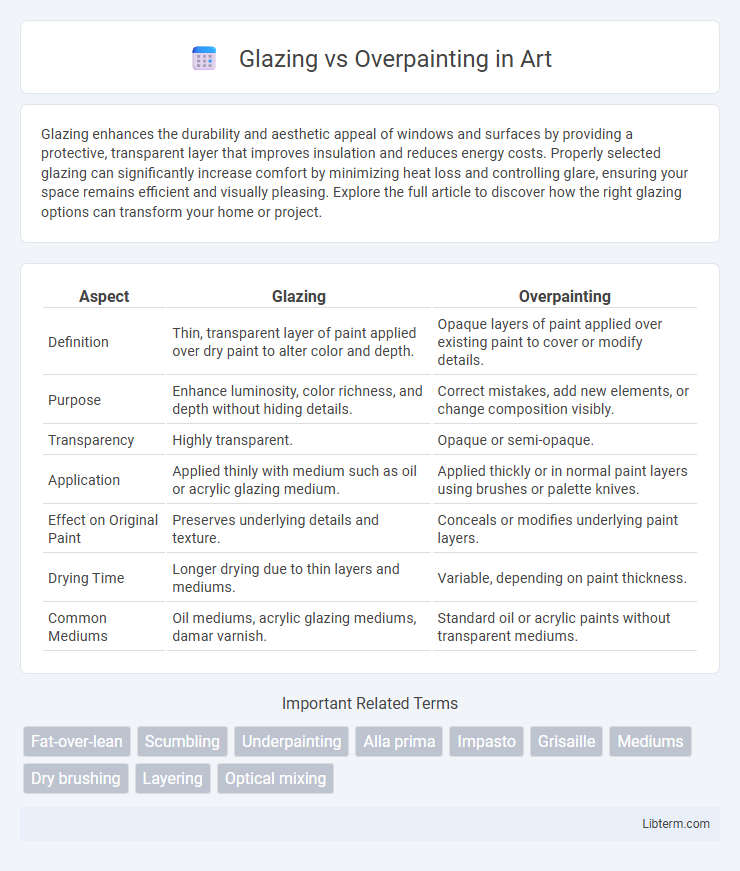Glazing enhances the durability and aesthetic appeal of windows and surfaces by providing a protective, transparent layer that improves insulation and reduces energy costs. Properly selected glazing can significantly increase comfort by minimizing heat loss and controlling glare, ensuring your space remains efficient and visually pleasing. Explore the full article to discover how the right glazing options can transform your home or project.
Table of Comparison
| Aspect | Glazing | Overpainting |
|---|---|---|
| Definition | Thin, transparent layer of paint applied over dry paint to alter color and depth. | Opaque layers of paint applied over existing paint to cover or modify details. |
| Purpose | Enhance luminosity, color richness, and depth without hiding details. | Correct mistakes, add new elements, or change composition visibly. |
| Transparency | Highly transparent. | Opaque or semi-opaque. |
| Application | Applied thinly with medium such as oil or acrylic glazing medium. | Applied thickly or in normal paint layers using brushes or palette knives. |
| Effect on Original Paint | Preserves underlying details and texture. | Conceals or modifies underlying paint layers. |
| Drying Time | Longer drying due to thin layers and mediums. | Variable, depending on paint thickness. |
| Common Mediums | Oil mediums, acrylic glazing mediums, damar varnish. | Standard oil or acrylic paints without transparent mediums. |
Introduction to Glazing and Overpainting
Glazing involves applying thin, transparent layers of paint to create depth, luminosity, and subtle color transitions in a work, enhancing the visual texture and richness of the image. Overpainting refers to applying opaque paint layers directly over an underpainting or existing paint to correct, alter, or refine details, providing a solid cover that masks prior layers. Both techniques are essential in fine art for achieving depth and detail, with glazing emphasizing light manipulation and overpainting focusing on surface adjustment.
Definition of Glazing in Art
Glazing in art refers to a technique where thin, transparent layers of paint are applied over a dry opaque layer to create depth and luminosity. This method enhances color richness by allowing light to pass through the glaze and reflect off the underlying paint. Unlike overpainting, glazing maintains the visibility of previous layers, contributing to a more nuanced and vibrant final image.
Understanding Overpainting Techniques
Overpainting techniques involve applying layers of paint atop dried underlying layers to modify or enhance the original image, differing from glazing, which uses transparent layers to alter color and light. Artists utilize overpainting to correct mistakes, add details, or change compositional elements, often employing opaque paints to create distinct visual effects. Mastery of overpainting requires understanding paint opacity, drying times, and color interaction to maintain harmony and depth within the artwork.
Historical Context and Evolution
Glazing and overpainting techniques have evolved significantly since the Renaissance, with glazing originating as a method to achieve luminosity and depth by applying transparent layers of oil paint. Overpainting became prominent in restoration practices during the 19th and 20th centuries to correct or enhance original artworks, often affecting the authenticity of historical paintings. These distinct methods reflect changes in artistic priorities and conservation ethics, influencing how art historians interpret and preserve cultural heritage.
Visual Effects Achieved with Glazing
Glazing creates luminous depth and subtle color transitions by applying thin, transparent layers of paint that enhance light reflection through the paint film. This technique allows artists to build rich, complex hues and a glowing effect unattainable with opaque overpainting alone. The visual impact of glazing emphasizes translucency and brilliance, offering a dynamic interplay of light and color that overpainting typically lacks.
Impact of Overpainting on Artwork
Overpainting can significantly alter an artwork's original texture and color depth, often obscuring the artist's initial intent and surface details. While glazing applies transparent layers to enhance luminosity and color richness without masking underlying paint, overpainting involves opaque layers that may compromise the visual harmony and historical authenticity. Conservators must carefully evaluate overpaint to determine restoration strategies that preserve the artwork's integrity and aesthetic value.
Key Differences between Glazing and Overpainting
Glazing involves applying thin, transparent layers of paint to achieve depth and luminosity, whereas overpainting uses opaque layers to cover or modify underlying colors and details. Key differences include transparency, with glazing enhancing color richness without obscuring base layers, while overpainting often changes or corrects existing paintwork. Glazing requires gradual layering to build tone and light effects, contrasting with overpainting's direct application for immediate visual alteration.
Choosing the Right Technique: Factors to Consider
Choosing between glazing and overpainting depends on factors such as the desired finish, transparency, and texture of the artwork. Glazing involves applying thin, transparent layers of paint to enhance luminosity, making it ideal for achieving depth and subtle color transitions. Overpainting suits corrections or bold changes, as it uses opaque layers to modify or cover underlying paint.
Common Mistakes in Glazing and Overpainting
Common mistakes in glazing include using overly thick layers that obscure details and failing to allow proper drying time between applications, resulting in muddied colors. In overpainting, artists often apply excessive paint, which can lead to a loss of luminosity and texture beneath, as well as increased drying times and cracking risks. Both techniques require careful control of medium consistency and layering to preserve depth and vibrancy in the final artwork.
Expert Tips for Combining Both Methods
Expert tips for combining glazing and overpainting emphasize applying transparent glazes first to build depth and luminosity, followed by precise overpainting to enhance details and adjust tones. Using glazing with oil or acrylic paints helps create rich color layers, while overpainting allows for corrections and fine-tuning highlights and textures. Maintaining a balanced approach ensures a harmonious finish, maximizing the strengths of both techniques in painting.
Glazing Infographic

 libterm.com
libterm.com